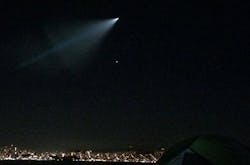Ballistic missile test firings off the California Coast were intended for a global audience
Eerie blue streaks of light were photographed from San Diego to San Francisco, and beyond during two separate test firings of the Lockheed Martin UGM-133A Trident II D5 submarine-launched ballistic nuclear missile -- one of the most advanced submarine-launched atomic missiles in the world.
The missiles were unarmed, of course; these were only tests -- most likely fired toward the Ronald Reagan Ballistic Missile Defense Test Site -- a 750,000-square-mile test range in the Pacific's Marshall Islands -- from the ballistic missile submarine USS Kentucky (SSBN-737).
It's about 4,000 nautical miles from the area off the California coast to the Marshall Islands -- just about at the limit of the Trident missile's known range.
The Ohio-class missile submarine Kentucky has been undergoing a major overhaul since 2012 -- including a mid-life nuclear refueling -- and the missile test firings this week were part of the long process of getting the Kentucky ready for ocean deployments.
The result was widespread shock and awe among coastal California residents who feared a real nuclear attack, a visit from aliens from outer space, some other type of UFO, or a variety of other things.
I grew up in Southern California, and have seen the condensation trails of ballistic missile tests, most of them launched from Vandenberg Air Force Base near Lompoc, Calif. They could be striking, especially when the launches were around sunset. These sightings were not common, but most people had an idea what they were.
This was before the Internet and social media, so we didn't have immediate wild speculation about enemy missile attacks and alien invasions. These occasions usually involved an item on the television evening news, with reports of many phone calls to local police. Such was life during the Cold War days of the '70s.
Navy officials contend the tests this week were conducted in secret. Well, yes and no. Sure the tests were a surprise to the population of Southern California, but the Navy wouldn't be able to give prior warning. Tipping off potential U.S. adversaries of a submarine missile test firing could risk compromising a bonanza of intelligence data.
Related: Lockheed Martin to manufacture new Trident II D5 submarine-launched nuclear missiles
Had potential U.S. adversaries like Russia and China known of the tests beforehand, certainly they would have had their own submarines in the area to gather every bit of information they could, ranging from the missile range and trajectory, to the precious sound signature of a U.S. ballistic missile submarine as it rises to launch depth and makes ready for firing.
Once recorded these sounds are stored in databases for future reference. Armed with this kind of information, today's sophisticated sonar systems often can identify not only the class of submarine from its sonar signature, but also each individual boat.
This is not to say that Russian or Chinese submarines weren't in the area off the California Coast during the test firings -- they might have been -- but why give away sensitive information if you don't have to?
Having said that, we do know the actual test firings weren't secret at all; they were spectacular. There's probably a reason for that, too. Most military tests are conducted in remote places away from prying eyes, but the Navy couldn't have chosen another place with such a huge audience for these tests.
Related: Draper Lab to help enhance accuracy and power of Navy's submarine-launched nuclear missiles
Los Angeles. During rush hour. Near sunset when the test would be most visible and dramatic. Under such circumstances, it would be staged for global consumption. I'm sure Russian and Chinese intelligence authorities got the message: the U.S. still have some of the most advanced and deadly nuclear weapons, and is testing them to make sure they work.
We're already seeing responses. Here's an AP headline from just this morning: "Russia to deploy new weapons to counter US missile shield." Most likely we'll see something from China later in the week. Very little goes on internationally at this level without some sort of response. This is just business as usual.
It's a shame these missile tests alarmed so many Californians, but think of it like this: those blue missile plumes shouldn't be scary. On the contrary, they should be comforting.
No matter what the military weapon is, you can't be sure it will work if needed unless you test it. The Navy is making sure its submarine-launched nuclear missiles work -- and is making sure potential adversaries know it, too.

